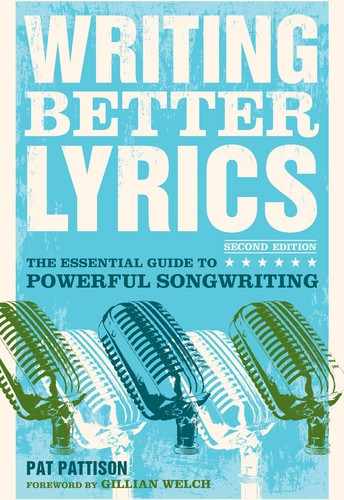CHAPTER TWO
RUSTY'S COLLAR
A LESSON IN SHOWING AND TELLING
Once you become adept in your object writing, with bushels of sense-bound images glittering on the kitchen table, what do you do with them? Here's some food for thought.
When I was in kindergarten, we got a new puppy.
I told Sister Mary Elizabeth, “I got a new puppy. His name is Rusty.”
“That's nice,” she smiled, in her kindergarten teacher sort of way.
“Can I bring Rusty to school for Show-and-Tell?”
“No, no,” she said, shaking her finger (they always shake their fingers). “We don't bring our pets to school.” (Who is we, anyway?)
I put on my best sad, irresistible face, and it had the usual effect. So she was quick to say, “But you could bring something of Rusty's, a picture, or his collar to show to the children. Then you could tell about him.”
I walked home as fast as I could after school — making my way nine blocks down Jessamine Avenue to Duluth Avenue, then another three blocks down Duluth to our row of Quonset huts — a whole mile!
A little breathless, I asked my mom, “Can I bring Rusty's collar to school tomorrow for Show-and-Tell?”
“Of course.”
I was excited all night. The next morning there was Rusty's collar laid out on the kitchen table next to my Superman lunchbox. What a good mom. I hurried through breakfast, pulled on my snowsuit, buckled my overshoes, wrapped my scarf around my face, yanked on my mittens, grabbed my lunchbox, and headed for St. Casimir's Grade School.
“I brought Rusty's collar for Show-and-Tell.”
“That's nice,” Sister Mary Elizabeth cooed, in her kindergarten teacher sort of way.
I hung my moon suit in the cloakroom and went to my desk to open my Superman lunchbox: a Spam sandwich with French's Mustard, a hard-boiled egg with salt wrapped in waxed paper, a banana, a celery stick with peanut butter in the groove, and Twinkies. No Rusty's collar.
Apparently, I had forgotten it in my hurry to leave. It was probably still on the kitchen table. I assumed that Mom had put it in my lunchbox.
“I forgot Rusty's collar. Mom didn't put it in my lunchbox.”
“Oh, I'm sorry,” said Sister Mary Elizabeth.
“Can I do Show-and-Tell anyway?”
“No, no,” she said gently, shaking her finger (they always shake their fingers). “You can't tell unless you show first.”
YOU CAN'T TELL UNLESS YOU SHOW FIRST.
To this day, I call that the “Sister Mary Elizabeth Rule of Song-writing.” Show before you tell. Showing makes the telling more powerful because your senses and your mind are both engaged.
The Sister Mary Elizabeth Rule of Songwriting says: First, hold up Rusty's collar, and then say what you will. Look at this example:
All the things we used to do
Those dreamy teenage nights
Nothing matters like it did
Back when you were mine
Try showing Rusty's collar first:
Hot rod hearts and high school rings
Those dreamy teenage nights
Nothing matters like it did
Back when you were mine
Think of Rusty's collar this way: “Hot rod hearts and high school rings” is a bag of dye. Hang the dye on top of the section and let it drip its colors downward onto the other lines, giving them more interest and depth.
Even if you show Rusty's collar just a little later:
Nothing matters like it did
Those dreamy teenage nights
Hot rod hearts and high school rings
Back when you were mine
We still get colors, but the law of gravity says that they'll only drip downward, leaving us starting with:
Nothing matters like it did
Those dreamy teenage nights
This has less color than when we followed the Sister Mary Elizabeth Rule of Songwriting. Colors drip down, not up. Show first, and watch everything else gain impact:
Hot rod hearts and high school rings
Those dreamy teenage nights
Nothing matters like it did
Back when you were mine
The teenage nights get dreamier. We're really able to feel the emotion of:
Nothing matters like it did
Back when you were mine
Now, look at this example, from Gillian Welch's “One More Dollar”:
A long time ago I left my home
For a job in the fruit trees
But I missed those hills with the windy pines
For their song seemed to suit me
So I sent my wages to my home
Said we'd soon be together
For the next good crop would pay my way
And I would come home forever
One more dime to show for my day
One more dollar and I'm on my way
When I reach those hills, boys
I'll never roam
One more dollar and I'm going home
Look what happens when we forget to bring Rusty's collar to school:
A long time ago I left my home
For a job in the city
But I miss that place and the things I did
Now it all seems so pretty
So I sent my wages to my home
Said we'd soon be together
For the next month's work would pay my way
And I would come home forever
One more dime to show for my day
One more dollar and I'm on my way
When I reach that place, boys
I'll never roam
One more dollar and I'm going home
Instant bland. David Rawlings, Welch's partner and an ardent student and practitioner of songwriting, called me with this beige version, remarking how he'd just turned the song into a disaster by trading the specific image for a cliché rhyme, city/pretty. “Look how completely it destroys a perfectly good work,” he chuckled.
When you're writing, it's fine to just let things flow. But always be on the alert for potential “collars.” Don't leave Rusty's collar on the kitchen table, no matter how excited you are to get to school and tell everyone about your new puppy.
The Sister Mary Elizabeth Rule of Songwriting: Show before you tell.
